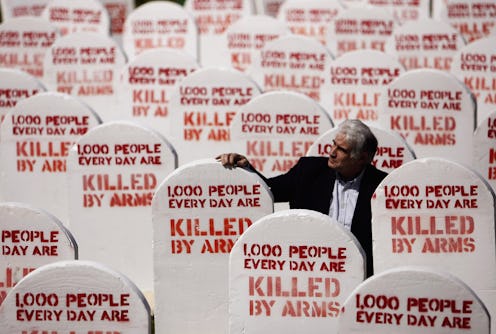News
Mass Shootings Aren't Going Away
On Wednesday, the FBI released a depressing — if not entirely unsurprising — report: instances of gunmen killing (or injuring) multiple people in crowded places have increased significantly over the last decade. Why are these mass shootings on the rise? Well, one suggestion is that of a cyclical phenomenon: The more shootings there are, the more would-be shooters are inspired to shoot, the more shootings there are... You get it. It's a loop. And it's tragic.
The study was looking particularly at "active shooter" situations: i.e., incidents where "an individual actively engaged in killing or attempting to kill people in a confined and populated area" — you know, like a college campus or a church. They ignored cases of drug and gang-based violence; this left them with what we typically think of as mass shootings. Someone opening fire in a crowded place, for what often appears to be no reason.
In terms of numbers, here's what the study found: Between 2000 and 2013, over 1,000 people died or were injured in 160 mass shootings. In the years between 2000 and 2007, there were six shootings a year, on average. That average rose to 16 per year in the last seven years.
These numbers, shocking as they are, are still lower than those suggested by an anti-gun violence group in an earlier report. That study found that, in the last two years, there have been 74 shootings in schools alone — an average of more than one school shooting per week.
Some other findings to take away from the report:
- Mass shootings were more common in businesses than in schools, although schools were the second-most chosen location for shooters (and most school shooters opened fire in their own schools).
- Almost all shootings were carried out by men. Seriously, of the 160 total shootings, 154 of the shooters were male.
- All but two were acting alone. In 25 percent of the incidents, the shooter turned the gun on himself before the cops got there.
Still, the burning question is: Why the increase? Is it, as many would suggest, that the nation's gun control measures are not doing what their name would imply: control? Or could it be the country's feeble mental health support system, which continues to limp along?
These are certainly factors — ones that should be the center-point of any debate on the topic, and Tom Junod's Esquire feature on the subject is well worth your time. But in many of the incidents, according to the report, the shooters had studied mass shootings that had been done before — especially the high-profile ones like those that took place at Columbine High School and Sandy Hook Elementary.
Andre Simons, a member of the FBI’s Behavioral Analysis Unit, told the AP that, often, would-be shooters are inspired by these past tragedies. He said:
The copycat phenomenon is real. As more and more notable and tragic events occur, we think we’re seeing more compromised, marginalized individuals who are seeking inspiration from those past attacks.
Over the last seven years, the Internet has boomed — according to Pingdom, Internet users across the world have gone up by over 1.1 billion since 2007, more than doubling in the last seven years. More and more people are reading, seeing and following incidents like mass shootings on the web. Shooters reach into people's homes via YouTube (and gain cult followings, sometimes). So it makes sense that would-be shooters are among those watching these media-frenzied tragedies take place.
Sadly, this shooters-inspired-by-shootings is a seemingly unbreakable cycle. Columbine author Dave Cullen has advocated not naming shooters at all, but unless (or until) we limit reporting on these incidents, there's not much more to be done. Except, perhaps, keep talking about better systems in place that will help the would-bes before they get "inspired." That's likely the best hope we have.
Images: Getty Images (3)
